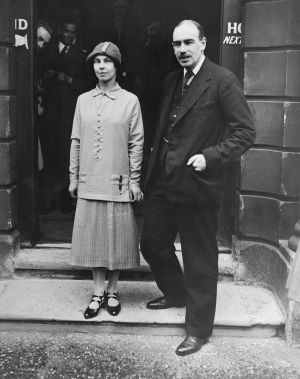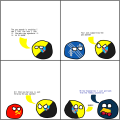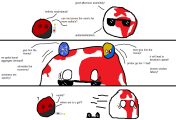Script error: No such module "Mbox".
The Keynesian School is an economically centrist ideology, whose general economic theory was pretty popular back in the day and still is in most of the western countries and ![]() Japan. He believes that the state should
Japan. He believes that the state should ![]() intervene in the economy to level out the economic cycle so businesses can make long-term investments and allow for long-run growth. He plans to do this by lowering taxes, lowering interest rates, and increasing spending when the economy busts, but also by cutting spending, raising interest rates, and raising taxes during economic booms.
intervene in the economy to level out the economic cycle so businesses can make long-term investments and allow for long-run growth. He plans to do this by lowering taxes, lowering interest rates, and increasing spending when the economy busts, but also by cutting spending, raising interest rates, and raising taxes during economic booms.
History
Keynesian economics was developed by the British economist John Maynard Keynes during the 1930s in an attempt to understand the Great Depression.
Variants
 Neo-Keynesian Economics
Neo-Keynesian Economics
The Neo-Keynesian Economic Theory is an economically centrist economic system, whose general economic theory is derived from the Neo-Classical economic thought in a mix with Keynesian economics.
A group of economists sought to synthesize the work of Keynes with numerous aspects of the neoclassical economic orthodoxy, this came to be known as the Neoclassical synthesis. This framework largely retained neoclassical analysis with regards to microeconomics and analysis on the level of the individual and/or the firm, while incorporating Keynesian analysis with regards to macroeconomics. This school of thought was dominant from the 1950s to the 1970s. Neo-Keynesianism fell out of favor due to the stagflation of the 1970s and the work of monetarists such as ![]() Milton Friedman.
Milton Friedman.
The two most prominent economic models with roots in Neo-Keynesian thought are:
- IS-LM model: It relates aggregate demand and employment to three exogenous quantities, i.e. the amount of money in circulation, the government budget, and the state of business expectations. It became really popular as a way to analyze the effect demand shocks on the overall economy
- Phillips curve : This curve was an empirical view of analyzing, to get to the conclusion, that more inflation would cause a lower employment rate.
 Post-Keynesian Economic Theory
Post-Keynesian Economic Theory
The Post-Keynesian Economic Theory is a more left-wing current of economic thought developed from the 1930s in England and the United States, where it is currently most present, which presents itself as the closest current to Keynes' ideas. It takes the most radical views of Keynes, who throughout his life has moved further and further away from neoclassicals. As such, the Post-Keynesian economic theory takes a position radically opposed to that of neoclassical economics by emphasizing the following points:
- A realistic and non-instrumentalist epistemology. The assumptions made by post-Keynesians must correspond to reality; they do not have a simple predictive function.
- A holistic and non-individualistic approach, for example, the possibility of an autonomous macroeconomics compared to the microeconomics, and an area of analysis and reflection specific to macroeconomics.
- Giving up on the assumptions of absolute or even limited rationality of agents.
- Considering the problem of scarcity in the economy as secondary; and placing the problems of production, reproduction, growth, and circulation at the center of the analysis.
- Favorising state interventionism over the free market.
- Inflation is analyzed from a cost-push perspective. Money is endogenous, wages in monetary terms are determined by oligopolies and unions, and the stock of capital is homogeneous.
 New Keynesian Economic Theory
New Keynesian Economic Theory
The New Keynesian Economic Theory is a macroeconomic school of thought that strives to provide more consistent micro-foundations to the Keynesian economic theory in response to sustained attacks from New-Classical economists. Like the Neo-Keynesian economic theory, the New Keynesian economic theory is Keynesian in the short run but neoclassical in the long run.
However, unlike the neoclassical synthesis, the New Keynesian economic Theory attempts to provide theoretical explanations for a variety of market failures, mainly through Microeconomic Foundations and Rational Expections
- Menu costs: The restaurants can print out new menus in response to their price changes, hence the name. However, menu cost is actually the cost of firms adjusting their nominal prices. The burden causes businesses to change prices slowly rather than continuously. The macroeconomic effect of changing a single firm's price on the demand of all products is called the "aggregate-demand externality."
- The staggering of prices: According to New Keynesians, enterprises don't set prices at the exact same time. Each one cares about its price relative to the ones charged by other firms. As a result, the prices are sluggish because no firms want to be the first to increase its price significantly.
- Coordination failure: In the real world, the number of businesses is very large, so it's hard to predict what others may do after the adjustment of the money supply. The failure of businesses to coordinate the changes in prices is a possible explanation for recessions.
- Efficiency wages: Markets may fail to clear due to the tendency for employers to pay above equilibrium wages. Abnormally high wages cause existing workers to be more productive and thus less likely to switch to a new job.
Moreover, the New Keynesian economic theory has two models that don't appear in the last iteration of the Keynesian Scool:
- New Keynesian DSGE model: Enterprises and households are assumed to have rational expectation, but prices are set by monopolistically competitive firms and can't shift quickly or without cost.
- New Keynesian Phillips Curve: Like an expectations-augmented Phillips curve, it implies that the trade-off between unemployment and inflation is only applicable in the short run.
Tenets
Keynesian economics is considered a "demand-side" theory that focuses on changes in the economy over the short run. Keynes’s theory was the first to sharply separate the study of economic behavior and markets based on individual incentives from the study of broad national economic aggregate variables and constructs.
Based on his theory, Keynes advocated for increased government expenditures and lower taxes to stimulate demand and pull the global economy out of the depression. Subsequently, Keynesian economics was used to refer to the concept that optimal economic performance could be achieved—and economic slumps prevented—by influencing aggregate demand through activist stabilization and economic intervention policies by the government.

Keynesian economics represented a new way of looking at spending, output, and inflation. Previously, what Keynes dubbed classical economic thinking held that cyclical swings in employment and economic output create profit opportunities that individuals and entrepreneurs would have the incentive to pursue, and in so doing correct the imbalances in the economy. According to Keynes’s construction of this so-called classical theory, if aggregate demand in the economy fell, the resulting weakness in production and jobs would precipitate a decline in prices and wages. A lower level of inflation and wages would induce employers to make capital investments and employ more people, stimulating employment and restoring economic growth. Keynes believed that the depth and persistence of the Great Depression, however, severely tested this hypothesis.
In his book, The General Theory of Employment, Interest, and Money and other works, Keynes argued against his construction of classical theory, that during recessions business pessimism and certain characteristics of the market economies would exacerbate economic weakness and cause aggregate demand to plunge further.
For example, Keynesian economics disputes the notion held by some economists that lower wages can restore full employment because labor demand curves slope downward like any other normal demand curve. Instead, he argued that employers will not add employees to produce goods that cannot be sold because demand for their products is weak. Similarly, poor business conditions may cause companies to reduce capital investment, rather than take advantage of lower prices to invest in new plants and equipment. This would also have the effect of reducing overall expenditures and employment.e
Personality
Keynesian School is the sort of guy who you know you can ask for help on homework, but you can't really remember ever having a proper conversation. He can become a little obsessive when it comes to refining mathematical models to prove his point, and this can make him seem disconnected.
Stylistic Notes
Keynesian School has multiple jokes about him which are displayed in his behaviors:
- He likes to break other people's windows.
- Likes to bury money in ditches to dig it up again.
- Big Consoomer
Likes to have gay sex with twinks.
How to Draw

The ball design is based on the Coat of Arms of John Maynard Keynes (Specifically the Escutcheon a.k.a. the Shield)
- Draw a ball.
- Fill it with blue.
- Draw three grey diagonal lines from top left to bottom right.
- Draw two fleur-de-lis symbols in the bottom left and top right with the same color.
- Draw the eyes and you're done.
| Color Name | HEX | RGB | |
|---|---|---|---|
| Blue | #105BB0 | 16, 91, 176 | |
| Grey | #B8C1CD | 184, 193, 205 | |
Relationships
Friends
 Social Liberalism - He's a good student who tends to agree with me on civil liberties. Just would like to see him go a bit further when it comes to economic interventionism.
Social Liberalism - He's a good student who tends to agree with me on civil liberties. Just would like to see him go a bit further when it comes to economic interventionism. Paternalistic Conservatism - You listened to my arguments and not
Paternalistic Conservatism - You listened to my arguments and not  his, smart move.
his, smart move. Social Democracy - I justify for him whatever he is doing.
Social Democracy - I justify for him whatever he is doing. Democratic Socialism - Couldn't care less about this socialism shtick but you often promote my ideas so I like you.
Democratic Socialism - Couldn't care less about this socialism shtick but you often promote my ideas so I like you. Industrialism - I helped him grow after WW2.
Industrialism - I helped him grow after WW2. Regulationism - I'm literally the same as him, but with more specific end goals and more precise rhetoric from some British chap named John!
Regulationism - I'm literally the same as him, but with more specific end goals and more precise rhetoric from some British chap named John! Neoconservatism - Military spending is a great way to help the economy!
Neoconservatism - Military spending is a great way to help the economy! New Keynesian Economics - I love you my son but you are too close to
New Keynesian Economics - I love you my son but you are too close to  them
them Post-Keynesian Economics - My weirdest son who still manages to follow in my footsteps.
Post-Keynesian Economics - My weirdest son who still manages to follow in my footsteps. Financialism - We need a strong central bank.
Financialism - We need a strong central bank. Georgism - Both Stiglitz and Krugman like your idea of a Land Value Tax. Not sure it should replace all other taxes though.
Georgism - Both Stiglitz and Krugman like your idea of a Land Value Tax. Not sure it should replace all other taxes though.
Frenemies
 Hayekism - In the long term we'll all be dead.
Hayekism - In the long term we'll all be dead. Neo Keynesian Economics - You are my son and I love you but quite hanging out with those
Neo Keynesian Economics - You are my son and I love you but quite hanging out with those  neoclassicals!
neoclassicals! Neoliberalism - I like you depending on your mood, my dear son.
Neoliberalism - I like you depending on your mood, my dear son. Though I'm still a bit pissed at how much you tried to undo my work even though I became a failure over time Protectionism - Protectionism is good but cant you import a bit more things?
Protectionism - Protectionism is good but cant you import a bit more things? Mercantilism - I learned a lot from him, but he's a bit too blunt when it comes to violence.
Mercantilism - I learned a lot from him, but he's a bit too blunt when it comes to violence. Corporatism - I took many ideas from you, but your idea of abolishing democracy is preposterous.
Corporatism - I took many ideas from you, but your idea of abolishing democracy is preposterous. Syndicalism - Stop complaining about wages already! Go on welfare you lazy, good-for-nothing commies!
Syndicalism - Stop complaining about wages already! Go on welfare you lazy, good-for-nothing commies! You know what? That was a bit too harsh of me,I'll let your unions strike, as long as you are not being violent. Social Libertarianism - I don't think you understand the business cycle, but at least you're fine with the FED.
Social Libertarianism - I don't think you understand the business cycle, but at least you're fine with the FED. Third Way - Same as soclib, but too willing to compromise with Chicago Economics.
Third Way - Same as soclib, but too willing to compromise with Chicago Economics. Chicago School - While I mostly disagree with him on Fiscal vs Monetary Policy, we both support Central Banking, Fiat Currency and Capitalism. Just wish you'd open up to Government Spending more...
Chicago School - While I mostly disagree with him on Fiscal vs Monetary Policy, we both support Central Banking, Fiat Currency and Capitalism. Just wish you'd open up to Government Spending more...
Enemies
 Communism - I am not a communist. On the contrary, my methods are the only way to stop communists!
Communism - I am not a communist. On the contrary, my methods are the only way to stop communists! Libertarianism - This simpleton doesn't like it when the machine goes BRRRR. And for the last time, I'm not a goddamn socialist just because I like government spending. Please understand already that socialism is not about the government doing things.
Libertarianism - This simpleton doesn't like it when the machine goes BRRRR. And for the last time, I'm not a goddamn socialist just because I like government spending. Please understand already that socialism is not about the government doing things. Minarchism - The country is in debt and you bought war bonds but I still got paid sucker!
Minarchism - The country is in debt and you bought war bonds but I still got paid sucker! Anarcho-Capitalism - Oh Christ... you're somehow way more idiotic than
Anarcho-Capitalism - Oh Christ... you're somehow way more idiotic than 
 those dorks lol.
those dorks lol. Fiscal Conservatism - The machine will go BRRRR whether you like it or not!
Fiscal Conservatism - The machine will go BRRRR whether you like it or not! Austrian School - Goldbug Detected, Opinion Invalid.
Austrian School - Goldbug Detected, Opinion Invalid. Illegalism - Anti-economy, hates state monopolies and order? Nightmare!
Illegalism - Anti-economy, hates state monopolies and order? Nightmare!
Further Information
Literature
- The General Theory of Employment, Interest and Money by John Maynard Keynes
- The Return of Depression Economics and the Crisis of 2008 by Paul Krugman
- The Economic Consequences of the Peace by John Maynard Keynes
- The Price of Peace: Money, Democracy, and the Life of John Maynard Keynes by Zachary D. Carter
- Conscience of a Liberal by Paul Krugman
- Questia List
Wikipedia
- Keynesian Economics
- Neo-Keynesianism
- New Keynesianism
- Post-Keynesian economics
- Keynesian Cross
- Military Keynesianism
- Keynes' theory of wages and prices
- Keynesian beauty contest
- Keynesian Revolution
- 2008–2009 Keynesian resurgence
- Category:Keynesian Economics
People
 John Maynard Keynes
John Maynard Keynes Hyman Minsky
Hyman Minsky Joan Robinson
Joan Robinson Michał Kalecki
Michał Kalecki 
 Lawrence Klein
Lawrence Klein Joseph Stiglitz
Joseph Stiglitz 
 Paul Samuelson
Paul Samuelson James Tobin
James Tobin Paul Krugman
Paul Krugman John Kenneth Galbraith
John Kenneth Galbraith John Hicks
John Hicks Ben Bernanke
Ben Bernanke
Videos
- Fear the Boom and Bust: Keynes vs. Hayek - The Original Economics Rap Battle and Fight of the Century: Keynes vs. Hayek - Economics Rap Battle Round Two by Emergent Order
Articles
Neoclassical Synthesis Keynesianism, New Keynesianism and Post Keynesianism: A Review
Gallery
-
Credit: u/bruno-radical, Source
-
Credit:
 Based and Jedpilled, Source
Based and Jedpilled, Source
-
Credit: bruno-radical
-
Credit:
 TheLegend2T, Source
TheLegend2T, Source
-
u/airpods_gang420 Source
-
-
Neo-Keynesianism








